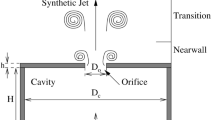Abstract
The effect of pressurized air inlets in the reservoir upstream of the annular slit on characteristics of the axial and tangential velocity components is investigated numerically, and the mechanism of occurrence of spiral nozzle flow is clarified. In simulations, Unified Platform for Aerospace Computational Simulation (UPACS) is used. The governing equations under consideration are the unsteady compressible Navier - Stokes. A second-order finite volume scheme with MUSCL (Roe scheme) is used to discretize the spatial derivatives, and a second order-central difference scheme for the viscous terms, and a MFGS (Matrix Free Gauss Seidel) is employed for time integration. Spalart-Allmaras model was used as a turbulence model. The results obtained are compared with velocity distributions in the experiment measured by the two-component fiber optic laser Doppler velocimeter system. The existence of discrete pressurized air inlets that leads to the occurrence of asymmetrical characteristics is a very important factor for the formation of spiral flow.
Similar content being viewed by others
References
Horii, K, Matsumae, Y, Cheng, X M, et al. Focusing Phenomena and Stability of Spiral-Flow Jet. Trans. Japan Soc. Aero. Space Sci., 1991, 33(102): 141–153
Takei, M, Horii, K, Hashimoto, B, et al. High Stability of Spiral Jet — Relations between Axial Velocity Distribution and Stability. J. of the Japan Soc. for Aeronautical and Space Sciences, 1995, 43(494): 9–16
Miyazaki, K, Chen, G, Kudamatsuo, J et al. High-Efficiency Soil Transportation with Spiral Airflow. Japan Soc. Aero. Space Sci., 1999, 42(137): 105–111
Ueda, H, Sakai, M, Horii, K, et al. Study of Swirling Pneumatic Transport of Granule in a Horizontal Pipe. Trans. Jpn. Soc. Mech. Eng., 2001, 67(664): 3011–3017
Horii, K, Sawazaki, H, Matsumae, Y, et al. New Continuous System for Dispersion and Encapsulation of Submicron Powders Using Spiral Flow. ASME, FED, 1990, 100: 25–30
Takei, M, Horii, K, Hashimoto, B, et al. Cutting of Soft Materials Using Spiral Water Jet. J. of the Japan Soc. for Aeronautical and Space Sciences, 1994, 42(490): 36–47
Horii, K, Matsumae, Y, Ohsumi, K, et al. Novel Optical Fiber Installation by Use of Spiral Flow. J. of Fluids Engineering, 1992, 114: 373–378
Horii, K, Matsumae, Y, Cheng, X M, et al. A Study of Spiral Flow (Part 4) The Effect of Radial Reynolds Number of Spiral Flow on Plasma Deposition of Pipe. Trans. Japan Soc. Aero. Space Sci., 1990, 32(98): 165–175
Yamane, T, Yamamoto, K, Enomoto, S, et al. Current Status of Common CFD Platform — UPACS, In: Proc. of Aerospace Numerical Simulation Symposium 2000, Tokyo, Japan, 2000. 45–50
Spalart, P R, Allmaras, S R. A on-equation Turbulence Model for Aerodynamics Flows. AIAA paper 92-0439, Reno, NV, USA, 1992
Bhagwat, M J, Leishman, J G. Correlation of Helicopter Rotor Tip Vortex Measurements. AIAA Journal, 2000, 38(2): 301–308
Author information
Authors and Affiliations
Rights and permissions
About this article
Cite this article
Kim, T.H., Matsuo, S., Setoguchi, T. et al. Study of spiral flow generated through an annular slit. J. of Therm. Sci. 14, 97–102 (2005). https://doi.org/10.1007/s11630-005-0017-z
Received:
Issue Date:
DOI: https://doi.org/10.1007/s11630-005-0017-z




